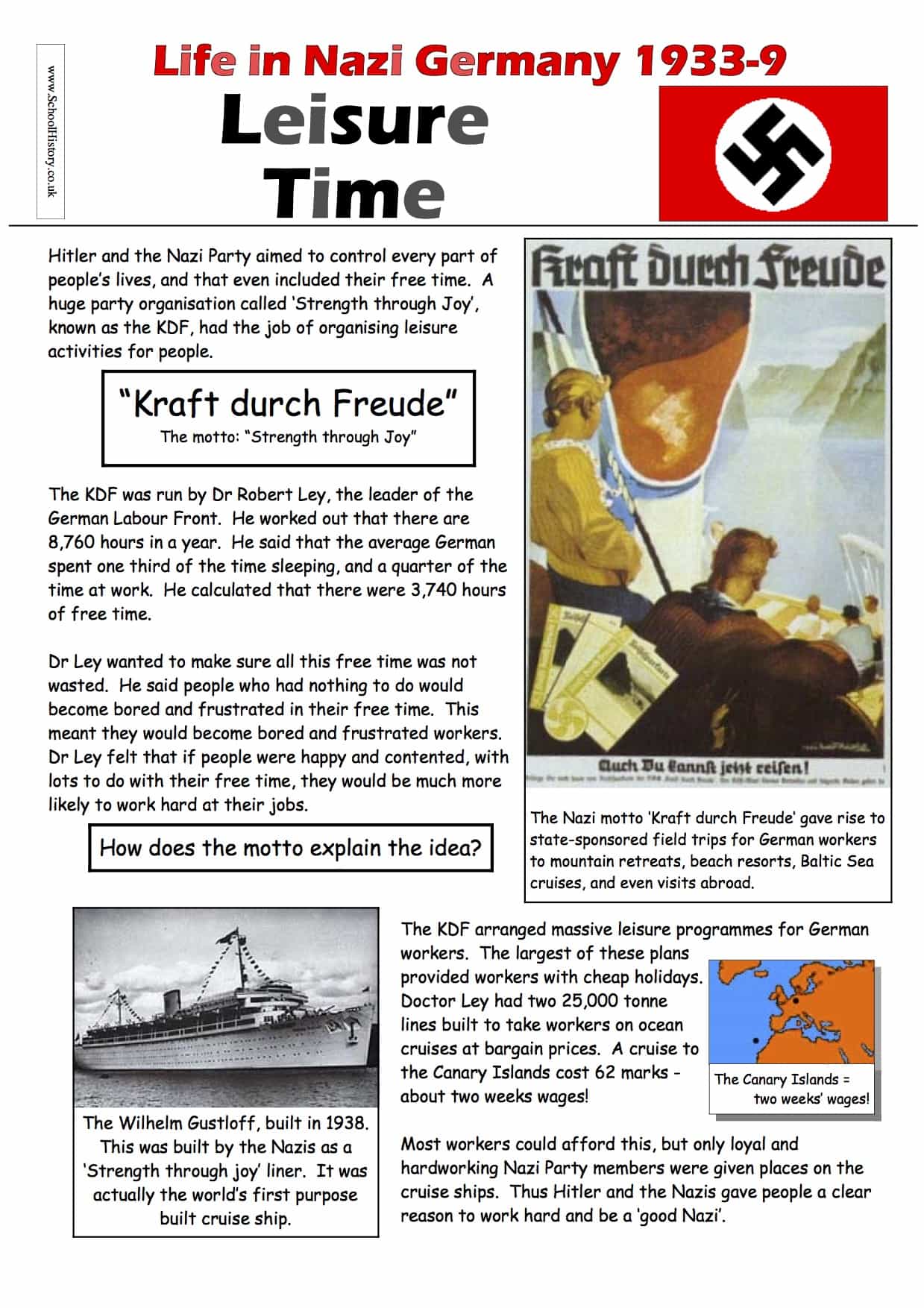Download Leisure Time in Nazi Germany
Click the button below to download this worksheet for use in the classroom or at home.
Download →
Hitler and the Nazi Party aimed to control every part of people’s lives, and that even included their free time. A huge party organisation called ‘Strength through Joy’, known as the KDF, had the job of organising leisure activities for people.
The KDF was run by Dr Robert Ley, the leader of the German Labour Front. He worked out that there are 8,760 hours in a year. He said that the average German spent one third of the time sleeping, and a quarter of the time at work. He calculated that there were 3,740 hours of free time.
Dr Ley wanted to make sure all this free time was not wasted. He said people who had nothing to do would become bored and frustrated in their free time. This meant they would become bored and frustrated workers. Dr Ley felt that if people were happy and contented, with lots to do with their free time, they would be much more likely to work hard at their jobs.
The KDF arranged massive leisure programmes for German workers. The largest of these plans provided workers with cheap holidays. Doctor Ley had two 25,000 tonne lines built to take workers on ocean cruises at bargain prices. A cruise to the Canary Islands cost 62 marks – about two weeks wages!
Most workers could afford this, but only loyal and hardworking Nazi Party members were given places on the cruise ships. Thus Hitler and the Nazis gave people a clear reason to work hard and be a ‘good Nazi’.
For those who could not get a place on a cruise ship, there were walking holidays in the mountains for 28 marks a week, or, in winter, skiing holidays in Bavaria. The price included travel, board and lodging, ski hire and skiing lessons from an instructor. Holidays in Switzerland were offered for 65 marks and tours of Italy for 115 marks. The KDF offered affordable but enjoyable holidays. It made people support the Nazi regime even more.
Entertainment:
Most forms of entertainment were controlled by the KDF. Seven million people took part in KDF sports matches each year, and there were mass outings to the theatre and the opera. The KDF had its own orchestra, which toured the country. It visited and played music in areas where orchestras did not usually go.
The Volkswagen:
According to Hitler, in the summer of 1932, while at a restaurant, he sketched a prototype for a car. In a time where only the richest people could buy a car, Hitler stated that all people should be given the chance to own one. This prototype became the Volkswagen Beetle.
Some historians think that someone else entirely came up with the idea – that an Austrian engineer called Ganz was responsible. They suspect that when Hitler discovered Ganz was Jewish, his designs were taken away and Hitler’s version of the prototype became the ‘official’ history.
Whatever the origin of the idea, Hitler ordered that a People’s Car (in German ‘Volkswagen’) should be built that anyone could afford. The final car was designed by an Austrian engineer, Ferdinand Porsche, who is supposed to have been told by Hitler that “it should look like a beetle”. The car was officially unveiled in 1938 and heralded as a triumph of Nazi Germany.
The price of a ‘beetle’ was set at 990 marks – equal to 35 weeks wages. To help workers buy a car, Doctor Ley started a hire-purchase scheme. Workers paid 5 marks a week until 750 marks were in the bank. Then they would be given an order number entitling them to a car as soon as it was made. No customer ever received their car. Even though workers paid millions of marks into the hire-purchase scheme, the Volkswagen factory was turned into a weapons factory as soon as the Second World War started in 1939.
The factory was heavily bombed during the war, but was reopened by the British and production of what became the world’s best selling production car officially began.
PDF Worksheet:
-
- Aimed at Students studying at UK GCSE or equivalent
- Free to download
- Use as you wish in the classroom or home environment
- Information sheet and challenging tasks.
